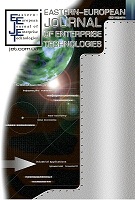
Бази даних
Наукова періодика України - результати пошуку
 |
Для швидкої роботи та реалізації всіх функціональних можливостей пошукової системи використовуйте браузер "Mozilla Firefox" |
|
|
Повнотекстовий пошук
| Знайдено в інших БД: | Реферативна база даних (6) |
Список видань за алфавітом назв: Авторський покажчик Покажчик назв публікацій  |
Пошуковий запит: (<.>A=Sytnik N$<.>) | |||
|
Загальна кількість знайдених документів : 9 Представлено документи з 1 до 9 |
|||
| 1. | 
Sytnik N. A study of fat interesterification parameters’ effect on the catalytic reaction activity of potassium glycerate [Електронний ресурс] / N. Sytnik, I. Demidov, E. Kunitsa, V. Mazaeva, O. Chumak // Восточно-Европейский журнал передовых технологий. - 2016. - № 3(6). - С. 33-38. - Режим доступу: http://nbuv.gov.ua/UJRN/Vejpte_2016_3(6)__6 | ||
| 2. | 
Bilous O. Development of a food antioxidant complex of plant origin [Електронний ресурс] / O. Bilous, N. Sytnik, S. Bukhkalo, V. Glukhykh, G. Sabadosh, V. Natarov, N. Yarmysh, S. Zakharkiv, T. Kravchenko, V. Mazaeva // Восточно-Европейский журнал передовых технологий. - 2019. - № 6(11). - С. 66-73. - Режим доступу: http://nbuv.gov.ua/UJRN/Vejpte_2019_6(11)__9 Розроблено антиоксидантний комплекс для використання в оліях, жирах і продуктах харчування, що потребують збагачення біологічно активними речовинами рослинного походження. Досліджено раціональні умови одержання водно-етанольних екстрактів із рослинної сировини: кори дубу, листя евкаліпту та листя зеленого чаю. Отримано антиоксидант, що здатен запобігати окисненню жировмісних продуктів, зберігаючи їх високу поживну цінність. Антиоксидантні речовини природного походження дозволять створювати збалансовані за складом продукти з підвищеним строком придатності зі збереженням початкового природного складу та структури компонентів. Також розроблений антиоксидант є додатковим джерелом речовин, що допомагають організму боротися з вільними радикалами, що утворюються внаслідок фізичних і психічних навантажень. До складу антиоксидантів рослинного походження входять антиоксидантні вітаміни (токофероли та аскорбінова кислота), рослинні феноли та тиолові антиоксиданти (глутатіон, ліпоєва кислота), мікроелементи. Ці складові беруть участь у процесах гальмування окиснення. Також до таких антиоксидантів входять селен, цинк, фолати та інші речовини. Для планування експериментальних досліджень для кожного виду рослинної сировини щодо антиоксидантної активності виділених речовин використано повний факторний експеримент першого порядку. Виявлено синергізм дії антиоксидантних речовин за одночасного використання екстрактів із кори дубу, листя евкаліпта, листя зеленого чаю. Розроблений антиоксидант підвищує період індукції модельної речовини (олії соняшникової) у 2,7 разу, тоді як під час використання антиоксидантів окремо з кожного виду рослин найкращий показник збільшення періоду індукції склав 1,9. Отже, розроблений антиоксидант здатен сприяти збереженню якості та безпечності жировмісних продуктів харчування. Використання даного антиоксиданту може бути запропоновано для продуктів харчування людей, що потребують додаткового введення антиоксидантів і біологічно активних речовин до раціону харчування. Зокрема, це є важливим для спортсменів. | ||
| 3. | 
Sytnik N. Research of oxidative stability of vegetable oils for use in sport nutrition [Електронний ресурс] / N. Sytnik, V. Mazaeva, O. Bilous, S. Bukhkalo, V. Glukhykh, G. Sabadosh, V. Natarov, N. Yarmysh, T. Kravchenko, S. Zakharkiv // Технологический аудит и резервы производства. - 2019. - № 6(3). - С. 30–34. - Режим доступу: http://nbuv.gov.ua/UJRN/Tatrv_2019_6(3)__9 | ||
| 4. | 
Labeiko M. Analysis of the influence of technological parameters of the chlorogenic acid extraction process from sunflower meal on the degree of its extraction [Електронний ресурс] / M. Labeiko, F. Gladkiy, S. Bochkarev, V. Mazaeva, Е. Litvinenko, T. Ovsiannikova, S. Zhyrnova, N. Sytnik // Технологический аудит и резервы производства. - 2020. - № 1(3). - С. 38–43. - Режим доступу: http://nbuv.gov.ua/UJRN/Tatrv_2020_1(3)__8 | ||
| 5. | 
Sytnik N. Determination of the influence of natural antioxidant concentrations on the shelf life of sunflower oil [Електронний ресурс] / N. Sytnik, E. Kunitsia, V. Mazaeva, A. Chernukha, O. Bezuglov, O. Bogatov, D. Beliuchenko, A. Maksymov, M. Popov, I. Novik // Восточно-Европейский журнал передовых технологий. - 2020. - № 4(11). - С. 55-62. - Режим доступу: http://nbuv.gov.ua/UJRN/Vejpte_2020_4(11)__8 Досліджено вплив природних антиоксидантів із різних видів рослинної сировини (РС) на процеси окиснювального та гідролітичного псування соняшникової олії під час зберігання. Рослинні антиоксиданти є більш екологічними та безпечними у порівнянні з синтетичними. Як РС використано листя зеленого чаю та кори дубу. До зразків олії додано водно-етанольні екстракти з РС у дослідних концентраціях. Зразки зберігалися в лабораторних умовах за температури 20 +- 2 <^>o | ||
| 6. | 
Sytnik N. Rational parameters of waxes obtaining from oil winterization waste [Електронний ресурс] / N. Sytnik, E. Kunitsia, V. Mazaeva, A. Chernukha, P. Kovalov, N. Grigorenko, S. Gornostal, O. Yermakova, M. Pavlunko, M. Kravtsov // Восточно-Европейский журнал передовых технологий. - 2020. - № 6(10). - С. 29-35. - Режим доступу: http://nbuv.gov.ua/UJRN/Vejpte_2020_6(10)__5 Production of waxes from spent perlite, which is a waste of sunflower oil winterization, is studied. Winterization is characterized by significant losses of oil with filter powders, and waste utilization is an environmental and economic problem. At the same time, winterization waste contains valuable components - wax and oil, which can be used in different ways. The content of waxes in spent perlite using hexane (18 %), as well as the quality indicators of the obtained wax: melting point 70 <^>o | ||
| 7. | 
Sytnik N. Establishing rational conditions for obtaining potassium glycerate [Електронний ресурс] / N. Sytnik, E. Kunitsia, V. Mazaeva, A. Chernukha, K. Ostapov, P. Borodych, V. Mazurenko, O. Kovalov, V. Velma, V. Kolokolov // Восточно-Европейский журнал передовых технологий. - 2021. - № 3(6). - С. 12-18. - Режим доступу: http://nbuv.gov.ua/UJRN/Vejpte_2021_3(6)__4 This paper reports a study into the dependence of efficient glycerate potassium production involving glycerin and potassium hydroxide solution on the process conditions. The concentration of potassium glycerate in the resulting product has been used as a parameter of the efficient glycerate potassium production process. Glycerates of metals are applied to produce articles in the construction industry, electronics, medicine; they are employed as transesterification catalysts to obtain special fats for various purposes, as well as biodiesel fuel. In order to derive potassium glycerate, heating was applied while agitating a mixture of glycerin and potassium hydroxide. The analysis of potassium hydroxide was performed, in which the basic substance mass fraction was 85,5 %, the mass fraction of carbonate potassium - 0,9 %. The p.a.-grade glycerin was applied in this work, whose basic substance mass fraction was 99,5 %. The effect of the heating temperature of the reaction mixture on the concentration of potassium glycerate in the product has been determined. It has been shown that the rational heating temperature is 145 <^>o | ||
| 8. | 
Sytnik N. Rational conditions of fatty acids obtaining by soapstock treatment with sulfuric acid [Електронний ресурс] / N. Sytnik, E. Kunitsia, V. Mazaeva, V. Kalyna, A. Chernukha, S. Vazhynskyi, O. Yashchenko, M. Maliarov, O. Bogatov, B. Bolibrukh // Eastern-european journal of enterprise technologies. - 2021. - № 4(6). - С. 6-13. - Режим доступу: http://nbuv.gov.ua/UJRN/Vejpte_2021_4(6)__3 As a result of alkaline neutralization of oils, a significant amount of soapstock is formed, the utilization of which creates an environmental and economic problem. The production of fatty acids from soapstock using sulfuric acid decomposition is investigated in this work. The peculiarity of the work is the determination of regression dependences of the yield and neutralization number of fatty acids on the soapstock processing conditions: temperature and duration. Soapstock obtained after neutralization of sunflower oil was used as raw material. Soapstock indicators: mass fraction of moisture - 15,4 %, total fat - 71,9 %, fatty acids - 64,5 %, neutral fat - 7,4 %. Rational conditions of soapstock processing are determined: temperature (90 - 95) <^>o | ||
| 9. | 
Sytnik N. Technology development of fatty acids obtaining from soapstok using saponification [Електронний ресурс] / N. Sytnik, E. Kunitsia, V. Kalyna, O. Petukhova, K. Ostapov, V. Ishchuk, D. Saveliev, T. Kovalova, O. Kostyrkin, O. Petrova // Eastern-european journal of enterprise technologies. - 2021. - № 5(6). - С. 16-23. - Режим доступу: http://nbuv.gov.ua/UJRN/Vejpte_2021_5(6)__4 The processing of oil refining waste is essential from economic and environmental points of view. An important issue is the processing of soapstock to extract fatty acids, which are raw materials for various industries. The two-stage method of fatty acids obtaining from soapstock using saponification with sodium hydroxide solution and decomposition with sulfuric acid is investigated. The peculiarity of the work is the study of the influence of soapstock saponification conditions on the key efficiency indicators of fatty acid extraction: yield and neutralization number. A sample of soapstock was obtained as a result of alkaline neutralization of sunflower oil. Soapstock quality corresponds to DSTU 5033 (CAS 68952-95-4): mass fraction of total fat - 68,5 %, fatty acids - 62,6 %, neutral fat - 5,9 %. Rational saponification conditions were determined: duration (85 min.) and concentration of sodium hydroxide solution (45 %). After saponification, the soapstock was subjected to decomposition with sulfuric acid under the following conditions: temperature 90 <^>o | ||
 |
| Відділ наукової організації електронних інформаційних ресурсів |
 Пам`ятка користувача Пам`ятка користувача |